#bianchini fabric
Explore tagged Tumblr posts
Text


Harper's Bazaar April 1958
Grès/Alix Collection Haute Couture Printemps/Été 1958 Dans le cadre néo-baroque et Belle Époque 1900 du restaurant gastronomique; Le Train Bleu de la gare Paris-Gare de Lyon; Ruth Neumann--Derujinsky porte une robe du soir aux plis droits, rose et mauve pâle, tombant d'un décolleté torsadé qui dévoile une épaule. L'emballage de cette confection : un foulard en mousseline vert citron de Bianchini. Jersey rayonne de Guillemin.
Grès/Alix Collection Haute Couture Printemps/Été 1958 Dans le cadre néo-baroque et Belle Époque 1900 du restaurant gastronomique; Le Train Bleu de la gare Paris-Gare de Lyon; Ruth Neumann--Derujinsky porte une robe du soir aux plis droits, rose et mauve pâle, tombant d'un décolleté torsadé qui dévoile une épaule. L'emballage de cette confection : un foulard en mousseline vert citron de Bianchini. Jersey rayonne de Guillemin.
Photo Gleb Derujinsky
#harper's bazaar#april 1958#fashion 50s#spring summer#printemps été#haute couture#grès/alix#madame grès#ruth neumann-derujinsky#gleb derujinsky#le train bleu#paris gare de lyon#bianchini fabric#guillemin fabric#vintage magazine#vintage fashion
35 notes
·
View notes
Text

Les Modes : revue mensuelle illustrée des arts décoratifs appliqués à la femme, no. 7, vol. 1, juillet 1901, Paris. Robe d'intérieur. — Style Louis XV. Modèle Redfern. Cliché Reutlinger. Bibliothèque nationale de France
ROBE D'INTERIEUR, Style Louis XV (Modèle Redfern). — Robe en tissu Bianchini. Foulard imprimé. Manches en guipure Venise mélangée d’or, garniture en soutache avec des pierreries fantaisie.
INTERIOR DRESS, Louis XV Style (Redfern Model). — Dress in Bianchini fabric. Printed foulard. Sleeves in Venice guipure mixed with gold, soutache trim with fancy gems.
#Les Modes#20th century#1900s#1901#periodical#fashion#fashion plate#color#photograph#description#bibliothèque nationale de france#dress#house dress#Modèles de chez#Maison Redfern#Reutlinger#july color plates
82 notes
·
View notes
Text


Paul Poiret & Raoul Dufy
Circa 1925 / 1926 - Bianchini-Ferier
Magnificent “Amphitrite” evening cape in gold laminated shaped silk crepe, plain, fringed finishes.
Main pattern dimensions: approximately 160 x 170cm
Length of fringes: approximately 42cm
Bibliography: Variation of the model exhibited at the Kyoto Costume Institute (n°AC9362 96-24-1)
Variation of the model in the book “Raoul Dufy L’oeuvre en Soie”, by Anne Tourlonias & Jack Vidal, published by Barthelemy - Avignon 1998, pages n°84-85:
“In 1925, with the Amphitrite paperback shawl, it goes more far into impertinence. Madame Poiret de Wilde: “I remember the day, probably a Thursday morning, when Charles Bianchini came to present to my father the collection which included the pink and gold naiads shawl on a brown background. I was about twelve years old and my taste was not mature either: accustomed as I was to seeing slender women, I had been shocked by these fat, naked, plump, buttocked bathers and found no favor in them. . “” “We dreamed of dazzling curtains and dresses decorated in the style of Botticelli. Without measuring my sacrifice, I gave Dufy, who was then just starting out in life, the means to make some of your dreams come true. Paul Poiret - Raoul Dufy's engravings quickly caught the eye of fashion designer Paul Poiret, who, seduced by the artist's decorative universe, offered to create fabrics for his fashion house.
In 1910, they therefore created a fabric printing workshop which they named "La Petite Usine", in which Dufy drew the patterns, engraved the wood used for printing, studied the necessary chemical techniques and sometimes went as far as print itself.
It was in 1912 that the Lyon silk firm Bianchini-Férier offered a contract to Raoul Dufy, so that he could produce textile prints for them, in complete freedom. Raoul Dufy continued his creations for both Paul Poiret and Bianchini-Ferier until 1928. » What echoes does this exciting period of my life awaken in me! Thanks to Poiret and Bianchini-Férier I was able to realize this relationship between art and decoration, above all to show that decoration and painting are quenched at the same source.” Raoul Dufy
https://www.invaluable.com/.../paul-poiret-raoul-dufy-308...
8 notes
·
View notes
Photo

Fabric samples in the June 1939 French Vogue.
(source: Gallica)
#vintage fashion#fabric#1930s fashion#french vogue#rodier#textile#chatillon mouly roussel#bianchini-ferier#ducharne#coudurier fructus descher#bucol
4 notes
·
View notes
Photo


Details of Landing Net, Tássia Bianchini
Pen on paper, 48 x 64 cm, 2019
#art#contemporary art#artists on tumblr#drawing#lines#tassia bianchini#contemporary drawing#textile#meditative practices#net#fabric#textiles#sigma micron
4 notes
·
View notes
Text
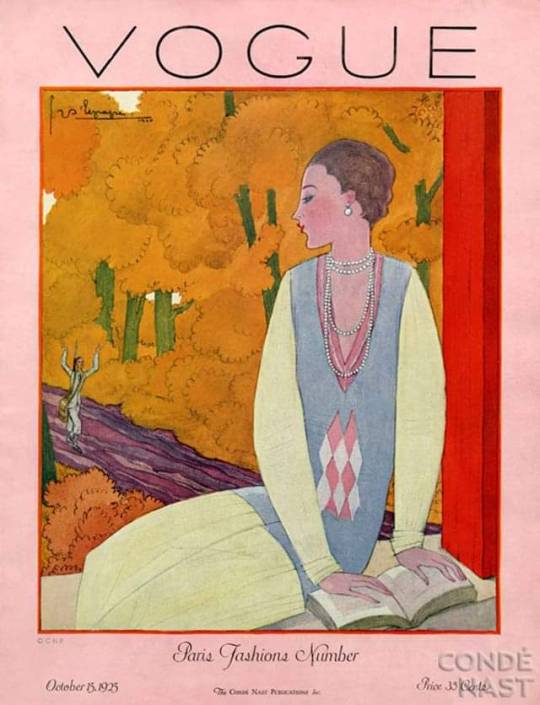
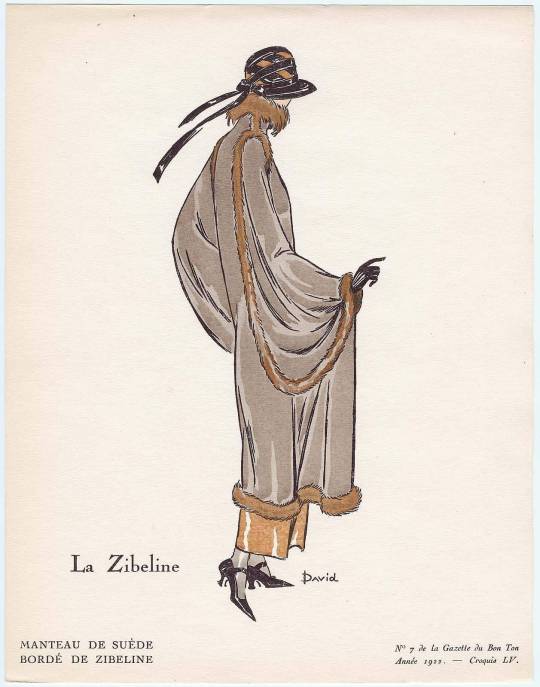
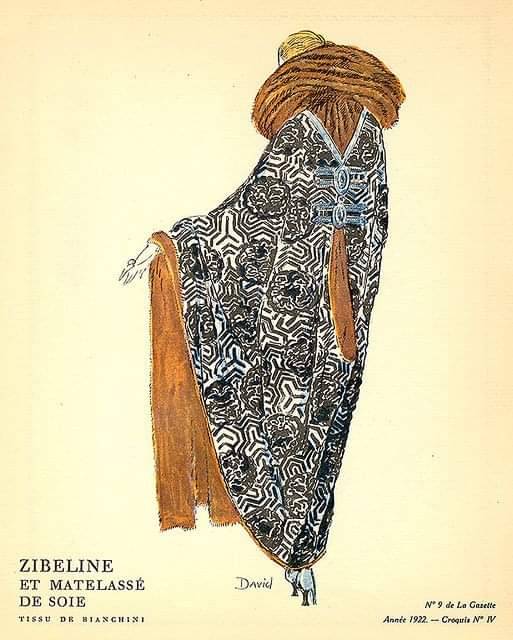
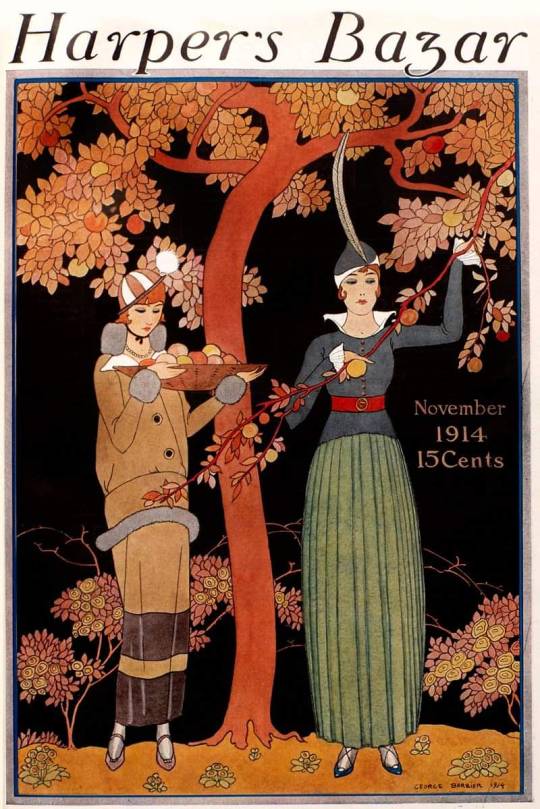
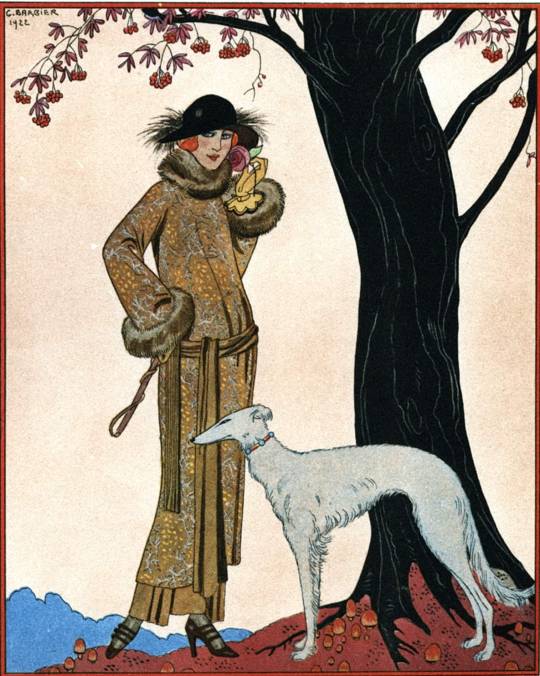

D'Artagnan.
" Autumnal fashions from 1914 -1925 illustrated by some of my favourite artists
#1 Vogue October 1925 cover illustrated by Georges Lepape
#2 1922 La Zibeline Manteau Court, en Fourrure et en Cuir," croquis LV from Gazette du Bon Ton, Volume 2, No. 7 Pochoir Illustrator David Size : 25.4 x 19.1 cm (10 x 7 1/2 in.) © MFA Boston
#3 .Zibeline et Matelasse de soie Tissue Biancini -Ferrier Illustrator: David 1922 : Sable and silk matelasse coat, fabric by Bianchini-Ferrier Croquis IV (4) in Gazette du Bon Genre, No. 9. Signed at bottom, "David." pochoir, hand col.; 25 x 19 cm. Publisher: Gazette du Bon Ton; distributed in the United States as Gazette du Bon Genre © Pratt Institute Libraries.
#4 Harpers Bazaar November 1914 by George Barbier
#5. George Barbier 1922
#6 La Mode pour l'Automne 1920," croquis XXXIV from Gazette du Bon Ton, Volume 2, No. 7 September 1920 Illustrated by Fernand Siméon (1884–1928)
Illustrating three designs by House of Worth (French, 1858-1956)
Illustrating one design by House of Beer (French, founded 1898) © MFA Boston
Love D’Artagan xxx".
3 notes
·
View notes
Photo










French fashions of the 1920s from the Gazette du Bon Ton
1. Bianchini-Ferier, Nov 1922 2. House of Worth evening dresses, art by George Barbier 3. ditto, June 1924 4. ditto, Dec. 1923 5. Jeanne Lanvin dinner gown, art by Pierre Brissaud, Feb 1922 6. ditto, April 1922 7. ditto, March 1922 8. Rodier fabric, March 1922 9. ditto 10. Rodier, art by Fernand Simeon, April 1922
#fashion#1920s#1920s fashion#couture#haute couture#outerwear#children's fashion#bianchini-ferier#house of worth#jeanne lanvin#rodier
1K notes
·
View notes
Photo


Jacques Fath’s Green Evening Dress: Peacock? Emerald?
While I am not clear what exact color makes up this beautiful evening gown at the Metropolitan Museum of Art, I can tell that Jacques Fath used a draped, attached shawl to soften the lines of this trim sleeveless sheath. The sheath was popular for daytime as well in the mid-1950s. Like all strapless dresses, this one is necessarily boned through the bodice, then a waistline ribbon holds it close to the body inside the dress. As this was custom made, it actually stayed up as it stayed close to the woman’s form. Since the draped scarf is sewn into the bodice as well as buttoned onto it, the buttonholes may work, but it’s doubtful they serve any purpose except to find another way to show off the gleam of the fabric.
The heavy silk satin was created by one of the old firms of Lyon which was known for is luxury silks, Bianchini-Férier. Silk takes dye so beautifully and seems to shimmer from within the threads; I don’t think any synthetic comes close to its drape and glow. And why settle for black when you can opt for such a lovely, deep color. I imagine this at its most dramatic worn by a redhead, although greens of various shades look good on many complexions.
Fath died young in 1954, so he is less remembered here than some of the other French designers, but he loved dramatic styles for evening. You can see this and many other lovely garments in the Costume Institute here:
https://www.metmuseum.org/art/collection/search/83230?&searchField=All&sortBy=Relevance&deptids=8&ft=fath%2c+jacques&offset=20&rpp=20&pos=38
#jacques fath#1950s fashion#vintage evening gown#vintage evening dress#1950s#vintage fashion#costume history#dress history#fashion history#fashion history museum#costume history museum#evening gown#evening dress#silk
24 notes
·
View notes
Text

US Vogue September 15, 1952
Ivy Nicholson wears an evening gown in white muslin by Bianchini and black velvet. By Jean Dessès for Nanty Frocks.
Ivy Nicholson porte une robe du soir en mousseline blanche de Bianchini et velours noir. Par Jean Dessès pour Nanty Frocks.
Photo Richard Rutledge vogue archive
#us vogue#september 1952#fashion 50s#fall/winter#automne/hiver#ready to wear#prêt à porter#jean dessès#nanty frocks#bianchini fabric#ivy nicholson#richard rutledge#vintage fashion#vintage vogue
33 notes
·
View notes
Photo

We want to give a huge thank you to our friends and supports over at @christopherfarrcloth for helping to spread word of the project and also donating over 20 meters of dead-stock fabrics to be handed out in our participant materials packages 🎉 . "La Jungle" is one of 11 selected textile designs from the archive of the renowned French artist Raoul Dufy who was active from 1905 until his death in 1953. A range of designs of big, bold floral to small geometric patterns in bright, fresh colours which @christopherfarrcloth respectfully reproduces. . Known for his oil and watercolours, as well as decorated ceramics, illustrated books, and a huge painted mural of 'Electricity' for the 1937 Paris International Exhibition. . Born at Le Havre in Normandy, awarded a scholarship in 1900 and went to Paris where he studied at the Ecole des Beaux-Arts. Influenced by the impressionist movement and fauve style of Matisse and began to work in richer vivacious colours. A contemporary of Picasso & Braque's, Raoul Dufy set up in 1911 a small factory to design and print fabrics for the couturier Poiret and the textile company Bianchini-Férier in Lyon. . Design: La Jungle in Caramel avaliable @christopherfarrcloth . Christopher Farr Cloth 32/33 Chelsea Wharf, 15 Lots Road, London SW10 0QJ Tel +44 (0)20 7349 0888 [email protected] . #brent2020 #brent #boroughofcultures #londonboroughofculture #mylocalculture #culture #arts #london #community #heritage #thisistheboroughofcultures #2020CultureFund #fashion #design #warrenreilly #fashioningourhistory #fohbrent #history #fashionhistory #community #art #artprogramme #edcuation #fashionillustration #ChristopherFarr #christopherfarrcloth #chelseawharf #chelseadesigncentre (at Christopher Farr Cloth) https://www.instagram.com/p/CKMLyb6g0Ng/?igshid=1ocnrzssgu39i
#brent2020#brent#boroughofcultures#londonboroughofculture#mylocalculture#culture#arts#london#community#heritage#thisistheboroughofcultures#2020culturefund#fashion#design#warrenreilly#fashioningourhistory#fohbrent#history#fashionhistory#art#artprogramme#edcuation#fashionillustration#christopherfarr#christopherfarrcloth#chelseawharf#chelseadesigncentre
0 notes
Photo

Raoul Dufy (French, 1877-1953) Fabric design of the “Bagatelle” tissue for Bianchini Férier, N/D Gouache.
14 notes
·
View notes
Photo

Length of jacquard woven silk furnishing fabric with a pattern of birds, flowers and leaves, designed by Jules Leleu and Madeleine Lagrange for Bianchini-Férier, made for the ocean liner Maréchal Pétain (subsequently renamed Marseillaise). 1941.
(source: MFA Boston)
3 notes
·
View notes
Photo

Detail - Landing Net (Knitting Series), Tássia Bianchini, Pen on paper, 48 x 64 cm / 18.9″ x 25.2″, 2019
7 notes
·
View notes
Text
Exuberant Leaves
Artist Raoul Dufy was one of the most successful and prolific textile designers of the period. The aesthetic sensibility of his woodcut prints was well suited to textile patterning. He developed a distinctively joyful style, producing literally thousands of designs while under contract with Lyons based luxury silk producer Bianchini-Férier between 1912 and 1928. The foliate motifs of this particular fabric are highly abstracted – proclaiming the modernity of the pattern. At the same time, they convey a sense of lush, dense vegetation, reflecting a fascination with the exotic that was evident in many of Dufy’s textiles.
from Cooper Hewitt, Smithsonian Design Museum http://ift.tt/2poACFO via IFTTT
3 notes
·
View notes
Text
Gilbert Adrian (1903-1959) built his career as a costume designer at Metro-Goldwyn-Mayer, where he worked on more than 250 films, including The Wizard of Oz. His creations for glamorous actresses such as Joan Crawford and Katharine Hepburn inspired women of all ages. Macy’s and other retailers recognized this as a marketing opportunity and opened small boutiques within department stores across the country — “cinema shops,” featuring ensembles based on costumes seen in Hollywood films. To promote them, MGM released a short film in 1940 entitled “Hollywood: Style Center of the World.” Encouraged by the success of the cinema shops, Adrian opened a fashion house in 1942 and began to create looks that appealed to his new leading lady: the American woman.
This exhibition, Adrian: Hollywood and Beyond, highlights both Adrian’s ready-to-wear and his costumes, while focusing on his innovative use of textiles. Beginning during his Hollywood days, fabric was central to Adrian’s aesthetic. He employed an arsenal of techniques — such as appliqué, piecing, mitering, pleating, and draping — to build dynamic garments in which the materials are as celebrated as they are integral to the design. Adrian worked with and endorsed different textile manufacturers throughout his career. Indeed, his final collection in 1952 was dedicated to the “beauty” and “integrity of fabric.”
Long evening dress in ivory rayon crinkle crepe printed with surrealist design of gray shattered monument stones with black shadows and yellow ancient inscriptions of keys, insects, eyes, timepieces, words, arrows, birds; deep-V suplice bodice with cap sleeves, asymmetrical black draped capelet, flared train
Adrian, evening dress, 1947, USA, textile by Salvador Dalí/Wesley Simpson, Gift of Lola Walker, P90.69.1 Adrian, two-piece evening ensemble, circa 1944, USA, Gift of Lola Walker, 70.40.2
Wesley Simpson, a New York textile converter who transformed the illustrations of artists such as Marcel Vertes and Ludwig Bemelmans into pattern repeats, provided Adrian with exciting rayons to animate his designs. Also during Adrian’s career, the textile industry embraced growing public interest in the fine arts — a connection that becomes clear when considering his rayon evening gown made from a Wesley Simpson print, based on an illustration by Surrealist artist Salvador Dalí (himself a frequent contributor to the fashion and textile worlds). Adrian recognized the value of this spectacular textile and composed a gown that is a harmonious union of print and fashion design. Using drapery and appliqué, he extended Dalí’s shadowy boulder motif into a dark capelet.
Adrian frequently used organzas, taffetas, and mousselines from Bianchini-Férier, a French silk mill that has produced fabric for couturiers since the nineteenth century. Although Adrian preferred to use rayon crepes to achieve his slim silhouette in the early 1940s, later in his career he turned to the lightness of Bianchini silks to create voluminous eveningwear. Adrian made Bianchini fabrics the focal point of his fall 1949 collection. Inspired by Africa, he chose textiles that ranged from a lamé snakeskin to a warp-printed silk tiger stripe.
Purple and brown horizontal striped wool suit with contrast vertical stripe peaked lapel, midriff panel and skirt; semi-fitted, with shoulder pads, single waistline button, calf-length skirt
Adrian, day dress, 1943, USA, printed rayon, 70.40.8 Adrian suit, 1945, USA, woolen textile by Pola Stout, 66.110.1
Adrian collaborated with woven textile designer Pola Stout throughout the 1940s. She sent striped and checkered wools to Adrian, who sketched garments inspired by her work and then returned the samples to be rewoven to his specifications. In Adrian’s hands, a restrained suiting fabric could become a bold and unique garment, often by means of mitering, the cutting and piecing together of fabric at an angle. Adrian’s collaborations with Stout resulted in some of his most celebrated suits, described by Vogue as “never melodramatic, never dull.” Designers who were trying to meet wartime fabric restrictions adopted the distinctive triangular silhouette — square, padded shoulders narrowing into a slim-hipped skirt — that Adrian had already perfected.
While best remembered for his tailored daytime looks, Adrian was also a skillful and inventive draper. He used this technique in both his film and fashion work to create glamorous evening gowns. In a stunning example from his last film, Lovely to Look At, Adrian draped a continuous length of fabric from the waist to a billowing sleeve, encircling the wearer to create a dramatic hood. In the exhibition, the costume is paired alongside a deceptively simple black dress from one of his earliest ready-to-wear collections. In both, Adrian’s unconventional and refined use of silk jersey is a highlight.
Adrian, costume, 1952, USA, from the film Lovely to Look At, 70.8.18 Adrian, suit jacket, circa 1950, USA, 73.66.1
From an examination of Adrian’s construction techniques and applications of textiles, a clear picture of the designer emerges — as both artist and engineer. As Eleanor Lambert, fashion publicist and founder of New York Fashion Week, wrote in a review of Adrian’s spring 1952 collection, “The fabric is the first signal that the costume is an Adrian.” His appreciation of textiles and their design potential set Adrian apart in Hollywood and beyond.
Adrian: Hollywood and Beyond has been organized by the graduate students in the Fashion Institute of Technology’s MA program in Fashion and Textile Studies: History, Theory, Museum Practice, with the support of Sarah Byrd, Ariele Elia, and Emma McClendon.
Share using #AdrianBeyond and on Twitter and Instagram.
FIT MUSEUM – Adrian: Hollywood and Beyond Gilbert Adrian (1903-1959) built his career as a costume designer at Metro-Goldwyn-Mayer, where he worked on more than 250 films, including
#ADRIAN#BIANCHINI#CALIFORNIA#CINEMA#COSTUMES#couture#FABRIC#FASHIONINSTITUTREOFTECHNOLOGY#fitmuseum#FITNYC#GILBERTADRIAN#hollywood#JOANCRAWFORD#KATHARINEHEPBURN#LAME#MGM#POLASTOUT#RAYON#readytowear#SILHUETTE#SILKJERSEY
0 notes
Photo
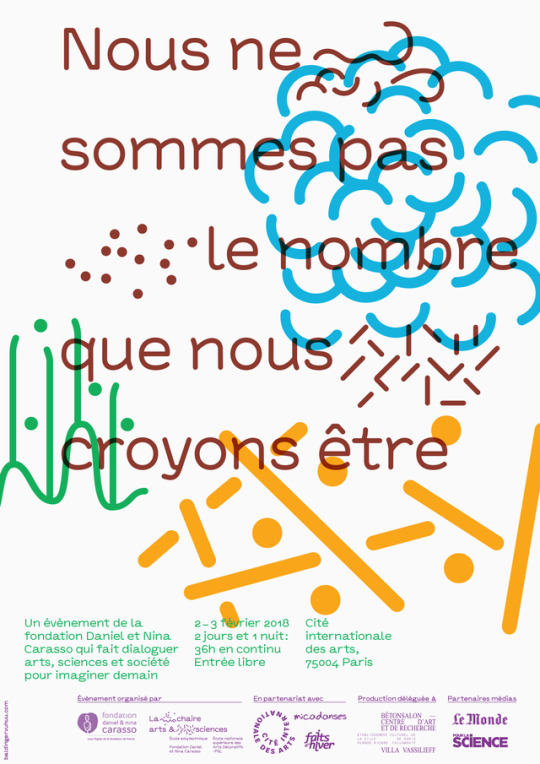
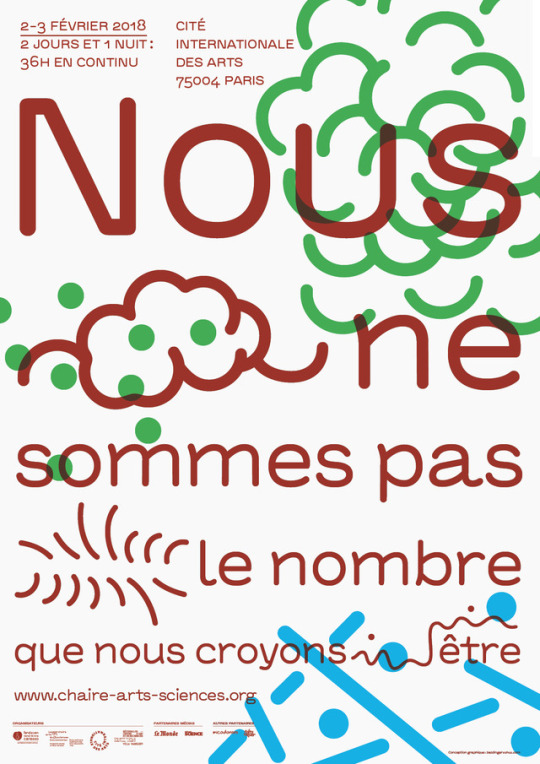

(CHECK THE WEBSITE : lancement chaire arts et sciences)
Chèr.e.s ami.e.s,
Venez débattre vendredi !Je vous invite à un “forum des controverses” sur les enjeux éthiques des maladies neuro-dégénératives (les ‘forums des controverses’ sont des débat-fictions participatif) avec le projet Éphéméride.
• 19h-21h ce vendredi • 17h-19h pour voir les conférences qui précèdent. • Cité Internationale des arts: 18 rue de l’hôtel de ville - 75004 • Débat dans l'Atelier 8220, noté numéro 9 sur le plan ci-joint
“NOUS NE SOMMES PAS LE NOMBRE QUE NOUS CROYONS ÊTRE” est le nom de l’événement art-science dans lequel s'inscrit un atelier thématique de 36h sur les savoirs médicaux, auquel je participe en organisant ce débat.
Le fil conducteur de ce foisonnant programme est l’univers d’un recueil de nouvelles de l’auteure américaine de science-fiction Ursula K. Le Guin, The Compass Rose (1982). J'interviendrai au sein de l’atelier qui reprend le titre d’une de ces nouvelles « L’eau est vaste ». Celle-ci attire notre attention sur les rapports que nous entretenons avec les savoirs scientifiques et médicaux qui ne nous encouragent pas toujours à oser explorer d’autres formes de relations de nos corps et de nos êtres à la multiplicité des mondes, visibles et invisibles, qui pourtant nous constituent.L'atelier est porté par Valérie Pihet du collectif Dingdingdong – Institut de coproduction de savoir sur la maladie de Huntington, co-fondé par 17 chercheurs, artistes et professionnels. Dans cet atelier, il s’agira de s’intéresser au « soin des possibles », pour suivre la philosophe Isabelle Stengers quand elle nous invite à penser les possibles contre les probables. Étant toutes et tous concerné.e.s dans une vie par la maladie, que l’on soit soi-même malade, proche d’un.e malade ou professionnel soignant, nous tâcherons d’explorer les manières de prendre soin des différentes formes de savoirs constituées à partir de nos expériences, et non en dehors d’elles. Pour ce faire, nous proposerons des espaces de partage de pratiques d’artistes et de chercheurs qui mettent leurs savoir-faire à l’épreuve de ces expériences, avec les personnes concernées. Nous explorerons également, par des expériences sensorielles – parfois virtuelles -, chor��graphiques et narratives, la question du soin à prendre des sens et des histoires qui nous fabriquent. Ces expériences inviteront les publics à s’éprouver comme faisceaux de relations, espace d’accueil, d’étreintes et de partage.
Programme spécifique de cet atelier :
De 15h à 18h le vendredi 2 février, rencontre avec des chercheurs, artistes et professionnels qui mettent leurs compétences et leurs savoir-faire à l’épreuve d’expériences partagées par des personnes concernées.
De 18h à 19h puis de 21h à 22h le vendredi 2 février, et enfin de 10h à 16h le samedi 3 février, retrouvez-nous pour explorer les possibilités narratives de la réalité virtuelle. Au programme, dans l’ordre, introduction/discussion, démonstrations et atelier de création proposés et animés par Fabien Siouffi (Dingdingdong, Fabbula), Ferdinand Dervieux (Parallèles Editions/Sharpsense) et Sarah Garcin (designer graphique et designer d’interaction). Plus d’info dans le document joint. ATTENTION : pour participer à l’atelier de création, je vous invite à vous inscrire, nombre de places limité : [email protected]
De 19h à 21h le vendredi 2 février, participez au débat conduit par Max Mollon, designer, enseignant et chercheur dédié au design fiction depuis 2010 (Design Fiction Club, Politique-Fiction, What if ? - bureau d’études du débat public). Il portera sur le temps de la maladie tant du point de vue des patients que des aidants. Cette concertation débutera par la présentation d’images fortes – conçues pour l’occasion, afin de stimuler le débat – qui mettent en perspective des scènes de vie de patients, et du même geste, des questionnements éthiques propres à ces sujets complexes.
De 22h à 10h la nuit du 2 au 3 février, venez nous rejoindre pour vivre une expérience sensorielle qui vous invitera à percevoir et ressentir les corps et les lieux comme des espaces de tâtonnement, d’étrangeté et de partage! Cette expérience est proposée par la chorégraphe Anne Collod (Cie … & alters, Dingdingdong).
De 18h à 19h30 le samedi 3 février, assistez à l’atelier « Tâla Médical » proposé par Luc Perera (chercheur en design sonore médical/programme doctoral SACRe), en présence de deux musiciens. Comment le design sonore médical et la musique classique de l’Inde du sud peuvent faire alliance pour tenter d’explorer une préoccupation politique et sociale majeure qui est le vieillissement de la population ? Quelle pratique pour quelle forme de soin ?
En permanence : exposition Dingdingdong – Institut de co-production de savoir sur la maladie de Huntington comprenant vidéos (deux capsules vidéo du docteur Marboeuf à propos de l’unité spéciale Alice Rivières et une vidéo intitulée Journal du futur d’Alice Rivières produites par le département «Narration spéculative» de L’Institut Dingdindong) et documents (posters et centre de ressources)
Je vous encourage vivement à regarder le programme de tout l'évènement. À consulter en ligne, ici.
Cet événement est proposé par la Fondation Daniel et Nina Carasso, en partenariat avec la Chaire “arts & sciences” (portée par l’École polytechnique / l’École nationale supérieure des Arts Décoratifs – PSL / la Fondation Daniel et Nina Carasso) et la Cité internationale des arts. Il rassemblera des centaines d’artistes, chercheurs et groupes de travail d’horizons géographiques et disciplinaires très variés autour d’une expérience inédite, en continu pendant 36h. Ils vous invitent à réfléchir sur le présent et à esquisser ensemble des voies d’avenir.Le programme est très riche et réuni Toutes les infos ici : http://chaire-arts-sciences.org/nous/
Avec la participation de (Warning, name dropping!) :
Bruno Latour, Pierre-Damien Huyghe, Christophe Leclercq , Giovanna Di Chiro, Laurent Jeanpierre, Kristin Ross, Emmanuel Mahé, Samuel Bianchini, Lucile Haute, Max Mollon, Ferdinand Dervieux, Sarah Garcin, Benoit Verjat, Nicolas Couturier, G.U.I., Julie Blanc, David Bihanic, Anthony Masure , Robin de Mourat , Vincent Piccolo , Annick Rivoire, Nolwenn Tréhondart, Valérie Pihet, Julia Morandeira, Arrizabalaga, Thierry Mouillé, David Zerbib, Naïm Aît-Sidhoum, Armand Béhar, Stéphane Bérard, Grégoire Bergeret, Filippo Broggini, Marie-Haude Caraès, Nicole MarchandZanartu, Matthieu Clainchard, Alexandre Costanzo, Anna Dezeuze, Elie During, Bastien Gallet, Gianni Gastaldi, Laurent Jeanpierre, Charlie Jeffery, Farah Khelil, Julia Kremer, Mauro Lanza, Frédérique Loutz, Sophie Mendelsohn, David Rabouin, Gaëtan Robillard, Didier Tallagrand, Christian Ruby, Linda Sanchez, Nicolas Tixier, Ewen Chardronnet, Aliens in Green , (groupe d’artistes composé, de Bureau d’études, Ewen Chardronnet, Mary Maggic, Julien Paris, Spela Petric), Xavier Bailly, Julien Bellanger, Benjamin Cadon, Nathalie Blanc, Lauranne Germond, Annick Bureaud, Isabelle Carlier, Erik Noulette, Chloé Desmoineaux, Nicolas Floc’h, Amanda Crabtree, Valérie Gentilhomme, Fabrice Lizon, Jeff Guess, Léa Le Bricomte, Robertina Sebjanic, Annie Sprinkle, Beth Stephens, Carole Thibaud, Miha Tursic, La Paillasse (Paris), Garance Malivel, Jamie Allen, Merle Ibach, Jennifer Crouch,, Nicholas Shapiro, Christophe Guérin , etc.
newsletter
0 notes